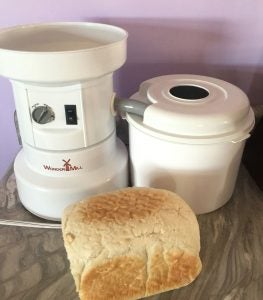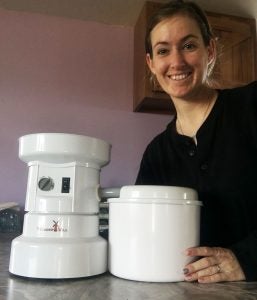Most of us row crop farmers don’t actually consume our own products, unless they’re put through livestock first. Recently, I did a deep dive in to the flour world after begging to grow wheat for years on our farm. We are a cow/calf operation with a corn-and-soybean rotation. We try growing cover crops in the off season for soil health and cattle grazing. What I didn’t realize is how easy it is to take the rye, corn, and wheat we grow and turn it in to flour that I can directly use in our kitchen.
Groceries aren’t going to get cheaper any time soon, so I look for any way I can to reduce that cost. Being able to mill our own flour cuts out having to buy it, but also adds so many health benefits. While I speak directly about wheat in this piece, understand that you can mill your own corn, rye, or other products as well. The price of inputs probably aren’t going down either for farming operations, so selling your wheat berries could be a way to add value to your operation. (Check all the regulations and licensing needed to do this in your state).
There’s another side to this, too. When people make the decision to lose weight, bread and carbohydrates are normally the first foods to get kicked out of their diets. But milling your own wheat from whole berries may mean you can have your cake and eat it too — capturing 40 of the 44 nutrients necessary to sustain human life. By milling your own flour you can get 90 percent of vitamins, minerals, protein, carbohydrates and fats you need.
What if bread wasn’t considered the food “enemy” but instead the staff of life that it has been considered throughout history?
By milling whole wheat berries right before use, you can capture all of these benefits.

I fully understand that time is a precious commodity. Before you completely disregard the option of milling your own flour, let’s break down how easy it is and why you should consider it.
Wheat berries consists of four parts: chaff (hull), bran, germ, and endosperm. The chaff is removed from the berry as it has no nutritional value for humans. The bran is the outermost layer. It has vitamin B and iron, as well as soluble and insoluble fiber. The germ is the most nutrient-dense part of the wheat berry. It contains fatty acids and lots of Vitamin E and B, antioxidants and minerals and several phytonutrients. The endosperm is mostly protein and starch with very few vitamins and minerals.
Whole grains don’t lose their nutritional value or turn rancid for thousands of years, if stored properly. Milled flour, commercially or home milled from the whole wheat berry, will quickly go bad. This is because the bran layer, which protects the seed, is lost and oxidation (exposure to air) begins right away and causes spoilage.
The bran and germ are removed from most commercially milled flour because the germ reduces shelf life substantially. Other products are added back into the flour that are shelf stable, which is why most flour we buy has “Enriched” on the bag.
While it’s easy to grab supplements to replace the items we’re missing, what if we allowed grain berries to do it for us? We can enjoy a delicious sandwich on fresh milled wheat bread while our gut bacteria gets the benefit of one of the most effective prebiotic nutrients.

Again, time. How do you find the time to not only make homemade bread, but fresh mill the flour as well? I’m a busy farmer and wife myself. I have lots of irons in the fire like we all do. I’ve found a routine that works for me because I saw the value in it. You have to decide if you’re willing to find the time or not. If you aren’t, that doesn’t mean you’re a terrible person. Everybody has different priorities. Maybe this isn’t yours right now. But if it is, it’s doable, even with chaotic schedules. Here’s how:
- Buy your mill of choice. I have a WonderMill because I found it on Facebook Marketplace. You can do all the research until you’re blue in the face about all the different types of mills out there. Fast, quiet and reliable were the criteria I was looking for.
- Find the educational materials. It’s not a 1:1 substitution with fresh milled flour and commercially processed flour. While every recipe can be substituted with fresh flour, you need the resources to teach you how. My favorite book is The Essential Home-Ground Flour Book by Sue Becker. She breaks down the what, when, where, and how of flour grinding. She also includes lots of recipes. Borrow it from your library if you’re on the fence. If you’re on social media, Unsifted, based out of Kansas City also has a ton of science dealing with fresh milled flour on their page. They do sell mills and berries, but it’s not necessary to purchase to get the benefit of their knowledge.
- Buy your wheat berries. This was the hardest part for me. All wheat is different and used for different purposes. That book (or the internet, I’m sure) will guide you to what wheat is best for what purpose. You can purchase in bulk, if you’re ready to jump in with both feet. Just make sure you are prepared to store correctly so you don’t have bug or rodent problems. For me, I bought smaller quantities. Most recipes call for a combination of several different wheat berries. I wanted to test it out before buying bulk. But now I’m hooked.
- Experiment, experiment, experiment. You’re a better baker than I am if your first attempts come out perfect. While they may not have all been visibly pleasing, all of my creations have been edible and delicious. Understand that your freshly milled flour creations are going to taste different than the store bought versions you’ve been used to. It will take trying different blends of berries and different recipes to find the ones you like. If your loaves are too crumbly for sandwich bread, make them in to bread crumbs or croutons. There’s always something to do with fresh baked bread. Don’t get frustrated by your first attempts. Keep trying, keep experimenting.
It’s one of those things, I always said there was no way. But I mill flour now without thinking. It literally takes longer to get the mill out of the cabinet and put the berries in it than it does to mill it. It adds maybe three minutes to the bread-baking process.
Since I’m a bread person (I love bread), I didn’t want to cut it out of my diet. Milling flour, I get to eat all the bread and get so many nutritional benefits from the wheat berries grown on farms all around the United States. Good luck and happy baking!
Kelsey Pagel is a Kansas farmer. She grew up on a cow/calf and row crop operation and married into another. Kelsey and her Forever (Matt) farm and ranch with his family where they are living their dream and loving most of the moments.



